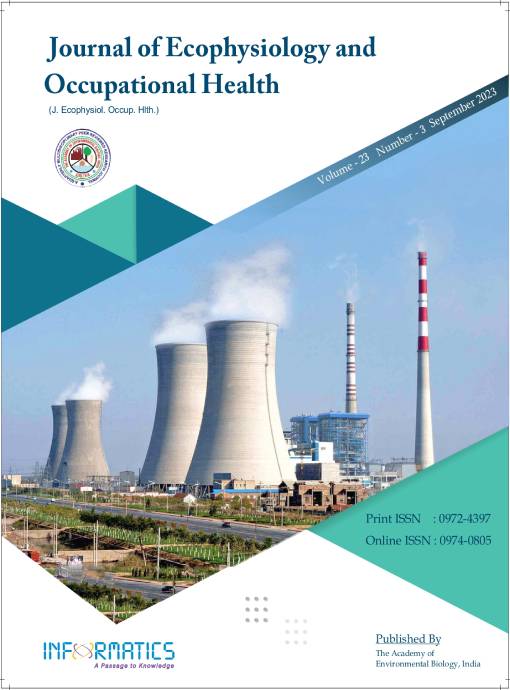Presence of Toxic Heavy Metals in Hill Water Bodies of Arunachal Pradesh, India – A Health Implication to the Indigenous Population
DOI:
https://doi.org/10.18311/jeoh/2023/30731Keywords:
Contamination, Ganga Lake, Metal, Poma River, Water QualityAbstract
Water bodies in hilly areas are considered the cleanest in India. They are also sites for household and recreation activities. On the contrary, they are disposal sites for household and toxic industrial wastes. This study evaluates the physio-chemical parameters and the toxic heavy metal content in two water bodies of Itanagar, the capital city of the Himalayan state of Arunachal Pradesh. Physiochemical parameters were evaluated using standard procedures and toxic heavy metal contents were analyzed using Inductively coupled plasma optical emission spectroscopy. The study revealed high dissolved oxygen contents in both water bodies. Other parameters such as alkalinity, carbon dioxide, phosphate, chloride, and nitrate contents were found to be within the permissible limits. However, lead and arsenic were found in trace amounts but below the permissible limits in both water bodies. Cadmium was exactly within the permissible limit whereas, antimony was found to exceed the permissible limit (0.010ppm). Also, chromium (0.070±0.002 ppm) in Ganga Lake and nickel (0.086±0.011 ppm) in Poma River were found to be above the permissible limits. The presence of toxic metals in these natural hilly areas is alarming and can be attributed to increasing anthropogenic activities. Adequate measures and precautions to prevent such contamination activities should be undertaken.
Downloads
Metrics
Downloads
Published
How to Cite
Issue
Section
License
Copyright (c) 2023 Amar Deep Soren, Balam Bayor, Akash Ekke

This work is licensed under a Creative Commons Attribution 4.0 International License.
Accepted 2023-07-10
Published 2023-09-19
References
Gorde SP, Jadhav MV. Assessment of water quality parameters: A review. International Int J Eng Res App. 2013; 6:2029–35.
Issakhov A, Alimbek A, Zhandaulet Y. The assessment of water pollution by chemical reaction products from the activities of industrial facilities: Numerical study. J Clean Prod. 2021; 282:125239. https://doi.org/10.1016/j.jclepro.2020.125239 DOI: https://doi.org/10.1016/j.jclepro.2020.125239
Yadav SS, Kumar R. Monitoring water quality of Kosi River in Rampur District, Uttar Pradesh, India. Adv Appl Sci Res. 2011; 2(2):197–201.
Overbo A, Heger S, Gulliver J. Evaluation of chloride contributions from major point and nonpoint sources in a northern U.S. state. Sci Total Environ. 2021; 764:144179. https://doi.org/10.1016/j. scitotenv.2020.144179 PMid:33385652 DOI: https://doi.org/10.1016/j.scitotenv.2020.144179
Huo C, Dar AA, Nawaz A, Hameed J, Albashar G, Pan B, Wang C. Groundwater contamination with the threat of COVID- 19: Insights into CSR theory of Carroll’s pyramid. J King Saud Univ–Sci. 2021; 33(2):101295. https://doi.org/10.1016/j. jksus.2020.101295 PMid:35996465 PMCid: PMC9387516 DOI: https://doi.org/10.1016/j.jksus.2020.101295
Kapoor D, Singh MP. Heavy metal contamination in water and its possible sources. In: Kumar V, Sharma A, Cerdà A, editors. Heavy metals in the environment, Impact, assessment, and remediation. Elsevier; 2021. p. 179–89. https://doi.org/10.1016/ B978-0-12-821656-9.00010-9 PMid:33795051
Mishra S, Kumar A. Estimation of physicochemical characteristics and associated metal contamination risk in river Narmada, India. Environ Eng Res. 2021; 26(1):190521. https://doi.org/10.4491/ eer.2019.521 DOI: https://doi.org/10.4491/eer.2019.521
Venkatesan G, Subramani T, Sathya U, Karunanidhi D. Evaluation of chromium in vegetables and groundwater aptness for crops from an industrial (leather tanning) sector of South India. Environ Geochem Health. 2021; 43:995–1008. https://doi. org/10.1007/s10653-020-00665-5 PMid:32696200 DOI: https://doi.org/10.1007/s10653-020-00665-5
Sharma BB, Sarma HP. Assessment of heavy metal pollution in a Himalayan River using multivariate statistical tools: A case study of the Kameng River in Arunachal Pradesh, India. Arab J Geosci. 2018; 11:308. https://doi.org/10.1007/s12517-018-3556-9 DOI: https://doi.org/10.1007/s12517-018-3556-9
Das BK, Kar D. Water Analysis of River Siang of Arunachal Pradesh, India. Oceanogr Fish Open Access J. 2017; 3(5):146–50. https://doi.org/10.19080/OFOAJ.2017.03.555623
Goswami R, Bhagat C, Lollen I, Neog N, Barache UB, Thakur R, Mahlknecht J, Kumar K. Potential arsenic–chromium– lead co-contamination in the hilly terrain of Arunachal Pradesh, North-Eastern India: Genesis and health perspective. Chemosphere. 2023; 323:138067. https://doi.org/10.1016/j. chemosphere.2023.138067 PMid:36812990 DOI: https://doi.org/10.1016/j.chemosphere.2023.138067
Patil PN, Sawant DV, Deshmukh RN. Physico-chemical parameters for testing of water – A review. Int J Environ Sci. 2012; 3(3):1194–207.
Bureau of Indian Standards (BIS: 10500). Indian standard specification for drinking water. Second Revision. New Delhi; 2012.
WHO. Guidelines for drinking-water quality. 4th ed incorporating the first addendum, World Health Organization (WHO), Geneva, Licence: CC BY-NC-SA 3.0 IGO978-92-4-154995-0; 2017.
Thomas CC, Nsonwu-Anyanwu AC, Usoro CAO, Agoro E-YS, Idenyi AN. Hepato-renal toxicities associated with heavy metal contamination of water sources among residents of an oilcontaminated area in Nigeria. Ecotoxicol Environ Saf. 2021; 212:111988. https://doi.org/10.1016/j.ecoenv.2021.111988 PMid:33548571 DOI: https://doi.org/10.1016/j.ecoenv.2021.111988
Smith SV, Hollibaugh JT. Annual cycle and interannual variability of ecosystem metabolism in a temperate climate embayment. Ecol Monogr. 1997; 67(4):509–33. https://doi.org/10.1890/0012- 9615(1997)067[0509:ACAIVO]2.0.CO;2 DOI: https://doi.org/10.1890/0012-9615(1997)067[0509:ACAIVO]2.0.CO;2
Kiran BR. Physico-chemical characteristics of fishponds of Bhadra project at Karnataka. Rasayan J Chem. 2010; 3(4):671–6.
Nyeche VN, Ajuogu PK, Nodu MN. Toxicological impact of crude oil contaminated water on the serum biochemistry of adult rabbits in the humid tropics. J Vet Adv. 2015; 5(4):685–92. https://doi.org/10.5455/jva.20150421011656 DOI: https://doi.org/10.5455/jva.20150421011656
Alfaifi A, El-Sorogy AS, Qaysi S, Kahal A, Almadani S, Alshehri F, Zaidi FK. Evaluation of heavy metal contamination and groundwater quality along the Red Sea coast, southern Saudi Arabia. Mar Pollut Bull. 2021; 163:111975. https://doi. org/10.1016/j.marpolbul.2021.111975 PMid:33493850 DOI: https://doi.org/10.1016/j.marpolbul.2021.111975
Tripathi SM, Chaurasia S. Detection of Chromium in surface and groundwater and its bio-absorption using bio-wastes and vermiculite. Eng Sci Technol Int J. 2020; 23(5):1153–61. https:// doi.org/10.1016/j.jestch.2019.12.002 DOI: https://doi.org/10.1016/j.jestch.2019.12.002
Tumolo M, Ancona V, De Paola D, Lasacco D, Campanale C, Massarelli C, Uricchio VF. Chromium pollution in European water, sources, health risk and remediation strategies: An overview. Int J Environ Res Public Health. 2020; 17:5438–62. https://doi.org/10.3390/ijerph17155438 PMid:32731582 PMCid:PMC7432837 DOI: https://doi.org/10.3390/ijerph17155438
Mujaibel LM, Kilarkaje N. Mitogen-activated protein kinase signaling and its association with oxidative stress and apoptosis in lead-exposed hepatocytes. 2013; 30(5):513–29. https://doi. org/10.1002/tox.21928 PMid:24293362 DOI: https://doi.org/10.1002/tox.21928
 Amar Deep Soren
Amar Deep Soren








